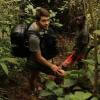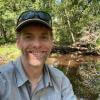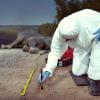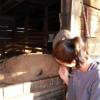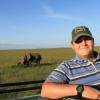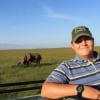Wildlife crime is one of the greatest challenges facing conservation, and one of the conservation tech world's biggest areas of innovation. With new ideas and solutions constantly being put forth to track and protect species targeted by poachers, manage protected areas and support rangers, and combat the growing online market for illegal wildlife products, the engineers and conservationists working to solve wildlife crime's many challenges rely on tools like machine learning, biologging, camera traps, acoustic monitoring, drones, mobile apps, and more.
This wide variety of overlapping technology makes our Wildlife Crime group a potential melting pot for many of our other communities, and makes it an especially exciting place to find collaborators working in different tech spheres to meet a common goal. Whether you're a camera trap expert looking for information on thermal vision to spot potential poachers, a machine learning expert with the skills to analyze acoustic data for gunshots, or a protected area manager seeking the latest integrated mobile tools, this group can connect you with the right members of our community!
Below, you'll find WILDLABS resources and conversations to help you understand how different technologies are being put to work in the fight against wildlife crime, and what conservation tech practitioners need for these tools to be effective.
Three Tutorials and Videos for Beginners:
- How do I use AI to fight wildlife crime? | Lily Xu, Tech Tutors
- WWF Wildlife Crime Technology Project | Eric Becker, Virtual Meetups
- SmartParks | Laurens de Groot, Virtual Meetups
Three Forum Threads for Beginners:
- Snare detection technologies | Rachel Kramer
- Tools for conservation management | Chris Muashekele
- Looking for Intelligence Database Software | Dexter Oelrichs
Three Articles for Beginners:
- Using AIS data to investigate the world's fishing ports, Max Schofield
- How do Wildlife Crime Experts view Remote Sensing Technologies used to Combat Illegal Wildlife Crime?, Isla Duporge
- Metal Detecting Sensors for Anti-Poaching, Sam Seccombe
Join this group now to get to know our community and start discussing solutions and ideas together!
Header photo: © Frank af Petersens/Save the Elephants
No showcases have been added to this group yet.


- 1 Resources
- 6 Discussions
- 3 Groups



- 1 Resources
- 12 Discussions
- 8 Groups
- @LindseyHarris
- | She, her
Head of Wildlife Trade, Fauna & Flora
- 0 Resources
- 0 Discussions
- 2 Groups
- 0 Resources
- 1 Discussions
- 4 Groups
Conservation Writer, Storyteller, & Digital Strategist
- 0 Resources
- 0 Discussions
- 5 Groups
Zoological Society London (ZSL)
Monitoring & Technology Lead, Conservation & Policy, ZSL

- 2 Resources
- 0 Discussions
- 2 Groups
Studying Biodiversity, Wildlife, and Ecosystem Health @ UEdi. Professionally software engineer, program manager, developer educator


- 0 Resources
- 7 Discussions
- 3 Groups
I've been working in IT for the past four years and Cybersecurity for the past year and a half. I'm looking to leverage my technical skills towards conservation purposes. I'm new on this journey and excited to jump of volunteer activities where I'm able!
- 0 Resources
- 0 Discussions
- 4 Groups
Dzanga-Ndoki national park biodiversity monitoring



- 0 Resources
- 64 Discussions
- 10 Groups
Technologist, birder, photographer and mountain guide.
- 0 Resources
- 0 Discussions
- 18 Groups
- @vandita_shukla
- | she/her
PhD candidate studying drone flight planning for enabling tracking and identification of individual characteristics of wildlife; member of the WildDrone, an MSCA Doctoral Network funded by the European Union’s Horizon Europe research
- 0 Resources
- 0 Discussions
- 20 Groups
Program Officer, Conservation Technology Program, WCS

- 0 Resources
- 0 Discussions
- 3 Groups
SMART combines a ranger-based data collection tool with capacity building and a suite of best practices aimed at helping protected area and wildlife managers better monitor, evaluate and adaptively manage their...
15 March 2016
When Victoria Espinel, President and CEO of BSA | The Software Alliance, spoke at the WWF Fuller Symposium, she took us on a whistle-stop tour of case studies where software and data are transforming our understanding...
10 March 2016
We are living in the midst of a pretty exciting era. Never before has humanity been more educated, more connected, more enabled, or more empowered than we are today. There are many reasons to be optimistic about the...
17 February 2016
New horizon scanning report published this month identifies 15 emerging threats and opportunities for global biodiversity.
3 February 2016
From artificial “sniffer” technologies to portable DNA sequencers, the Wildlife Crime Tech Challenge received hundreds of innovative ideas to help stamp out wildlife crime. Now, the Challenge is proud to announce 16...
22 January 2016
Gary Atkinson, Director of Emerging Technologies at ARM, explains why we should be interested in the Internet of Things. Could it be a game changer for conservation?
10 December 2015
Can games have real world impacts on issues like the illegal wildlife trade? In part two of his case study for the Gaming for Conservation Group, Peter Jacobs discusses United for Wildlife's efforts to engage young...
3 December 2015
The 2015 Fuller Symposium brought together thought leaders in science, policy, business, conservation and development to tackle emerging issues facing our planet. This framing piece was developed to support a Fuller...
26 November 2015
Article
Traceability (knowing where products come from and how they are made) is a foundational pre-cursor for many sustainability interventions. While many tools have been developed to offer high-level insight about the...
26 November 2015
Can games raise awareness of conservation issues like the illegal wildlife trade? In part one of his case study for the Gaming for Conservation Group, Peter Jacobs discusses how United for Wildlife is partnering with...
25 November 2015
Article
Environmental DNA (eDNA) is nuclear or mitochondrial DNA that is released from an organism into the environment. Sources of eDNA include secreted faeces, mucous, gametes, shed skin, hair and carcasses. In this article,...
2 November 2015
September 2025
November 2023
May 2023
event
March 2023
event
January 2023
42 Products
1 R&D Projects
42 Organisations
Recently updated products
Recently updated R&D Projects
Recently updated organisations
| Description | Activity | Replies | Groups | Updated |
|---|---|---|---|---|
| Hi Robynne - I'm really glad you're interested. I'm running a cohort at the moment but have so far only covered some QGIS basics so you would be welcome to jump on from next... |
|
Wildlife Crime | 1 week 2 days ago | |
| I create ocean exploration and marine life content on YouTube, whether it be recording nautilus on BRUVs, swimming with endangered bowmouth... |
|
Acoustics, AI for Conservation, Animal Movement, Camera Traps, Citizen Science, Drones, Emerging Tech, Marine Conservation, Sensors, Sustainable Fishing Challenges, Wildlife Crime | 1 month 2 weeks ago | |
| Hi WILDLABS Community! I have started mapping the project for the Gulf of America Dead Zone and here are some photos of the progress. In the last picture, I have... |
|
Climate Change, Marine Conservation, Wildlife Crime | 1 month 3 weeks ago | |
| Thank you for your reply, ChadI meant 10 as a whole, indeed. Perhaps you see your post in one group, but since it is tagged for all groups, I assumed you meant 10 in total.In your... |
|
Acoustics, AI for Conservation, Animal Movement, Camera Traps, Citizen Science, Climate Change, Community Base, Connectivity, Drones, eDNA & Genomics, Emerging Tech, Funding and Finance, Geospatial, Human-Wildlife Coexistence, Software Development, Wildlife Crime | 1 month 3 weeks ago | |
| HiThis is great! So just to double check - there is no way to join online? I would love to be part of this conference. Thanks, Els van Lavieren |
|
Community Base, Conservation Tech Training and Education, Data management and processing tools, Emerging Tech, Human-Wildlife Coexistence, Protected Area Management Tools, Wildlife Crime | 2 months 2 weeks ago | |
| Hi @iainmcnicol , welcome to WILDLABS! Thanks for posting this on here. I have shared with my colleagues at Fauna & Flora who have some experience (especially with the... |
|
Community Base, Geospatial, Protected Area Management Tools, Wildlife Crime | 4 months 1 week ago | |
| Hi Georg,Oh, that's a pity. But thanks anyway for checking!Really appreciate it!CheersMartina |
+10
|
Wildlife Crime | 3 months ago | |
| Hi Adam! Sounds like you have your work cut out for you. I have not used radar systems or AI systems for this sort of detection, but there are methods using change detection... |
|
AI for Conservation, Drones, Wildlife Crime | 3 months 3 weeks ago | |
| Great dear Travis,This is a great news and an opportunity to me and my local bee keepers. It really sounds very helpful.Here is my contacts:Email: muganyizi@pales.or.tz ... |
|
Climate Change, Conservation Tech Training and Education, East Africa Community, Funding and Finance, Human-Wildlife Coexistence, Wildlife Crime | 4 months 1 week ago | |
| You can also check out WWF's newly launched C2C: Conflict to Coexistence approach. It provides a framework and methodology for developing tailor-made human-wildlife conflict (HWC... |
+2
|
Wildlife Crime | 6 months ago | |
| Not a book, but a very real documentary:Stroop - Journey into the Rhino Horn War |
|
Wildlife Crime | 6 months 1 week ago | |
| Thank you so much for sharing! They seem to only state the official DFFE statistics nowadays. From my connections in SouthAfrica these numbers don't always seem to reflect... |
|
Wildlife Crime | 6 months 1 week ago |








